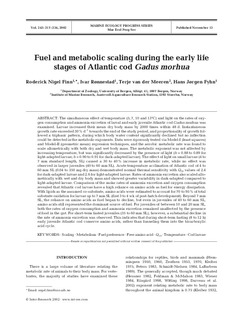| dc.description.abstract | The simultaneous effect of temperature (5, 7, 10 and 13degreesC) and light on the rates of oxygen consumption and ammonia excretion of larval and early juvenile Atlantic cod Gadus morhua was examined. Larvae increased their mean dry body mass by 2000 times within 48 d. Instantaneous growth rate exceeded 30 % d(-1) towards the end of the study period, and proportionality of growth followed a triphasic pattern, during which body water content significantly declined but no inflection could be detected in the metabolic exponents. Data were rigorously tested via Model-I (least squares) and Model-II (geometric mean) regression techniques, and the aerobic metabolic rate was found to scale allometrically with both dry and wet body mass. The metabolic exponent was not affected by increasing temperature, but was significantly decreased by the presence of light (b = 0.88 to 0.89 for light-adapted larvae; b = 0.90 to 0.91 for dark-adapted larvae). The effect of light on small larvae (4 to 7 mm standard length, SL) caused a 30 to 40% increase in metabolic rate, while no effect was observed in larger juveniles (40 to 60 mm SL). Acute temperature acclimation of Atlantic cod of 4 to 60 mm SL (0.04 to 350 mg dry mass) demonstrated normal thermal sensitivity with Q(10) values of 2.4 for dark-adapted larvae and 2.6 for light-adapted larvae. Rates of ammonia excretion also scaled allometrically with wet and dry body mass and showed greater variability in dark-adapted compared to light-adapted larvae. Comparison of the molar rates of ammonia excretion and oxygen consumption revealed that Atlantic cod larvae have a high reliance on amino acids as fuel for energy dissipation. With lipids as the assumed co-substrate, amino acids were estimated to account for 70 to 95 % of total substrate oxidation for larvae up to 7 mm. SL (first 3 to 4 wk of post-hatch development). Beyond 7 mm. SL, the reliance on amino acids as fuel began to decline, but even in juveniles of 40 to 60 mm SL, amino acids still represented the dominant source of fuel. For juveniles of between 10 and 20 mm SL, both the rates of oxygen consumption and ammonia excretion remained unaffected by the presence of food in the gut, For short-term fasted juveniles (35 to 60 mm SL), however, a substantial decline in the rate of ammonia excretion was observed. This indicates that during short-term fasting (8 to 12 h) early juvenile Atlantic cod conserve amino acids, rather than funneling them into the tricarboxylic acid cycle. | en |
